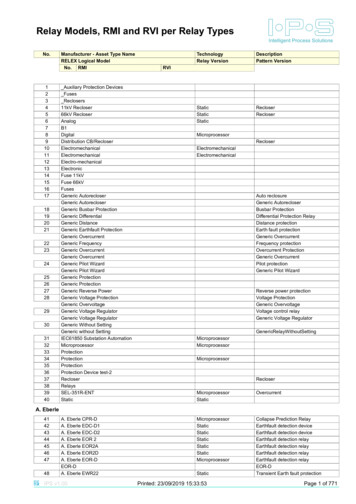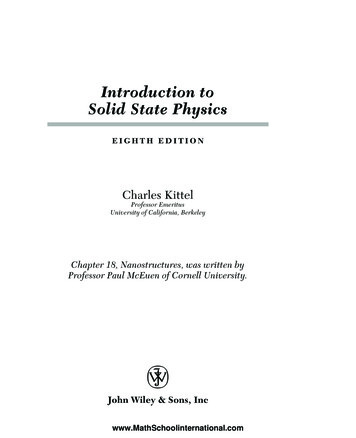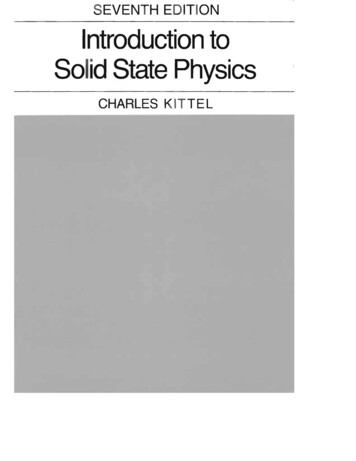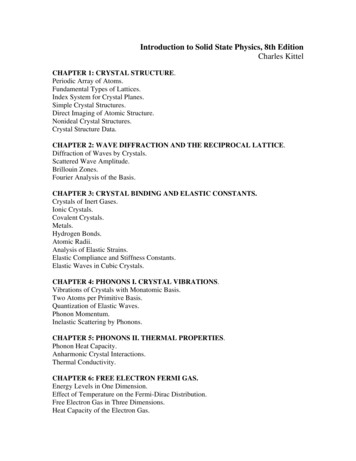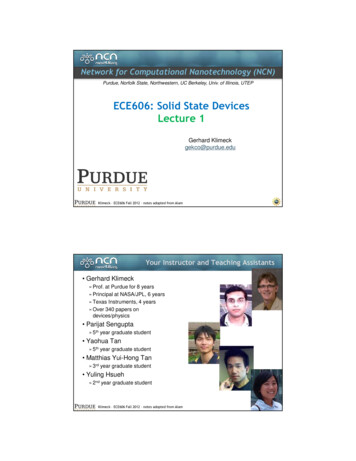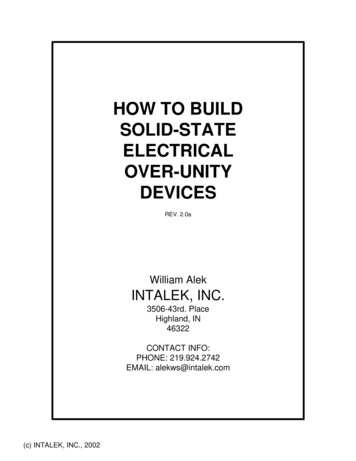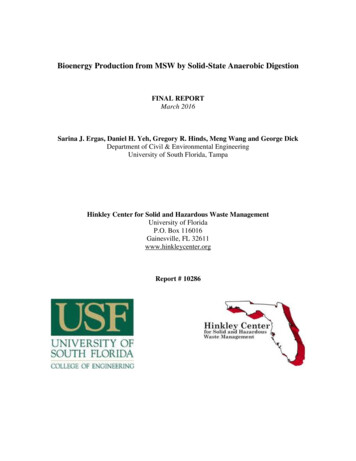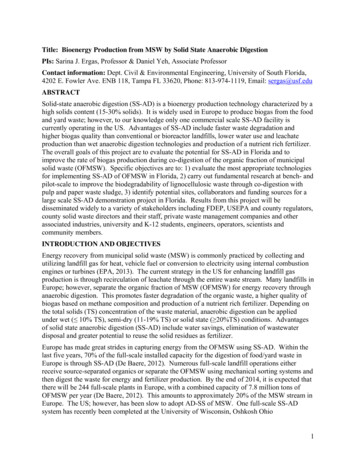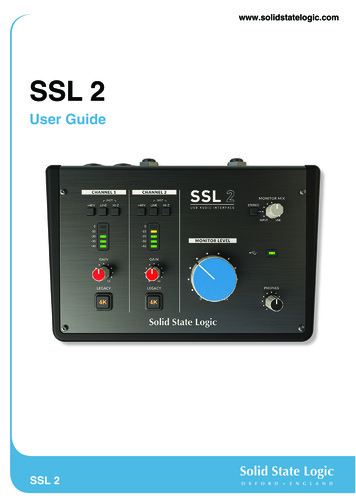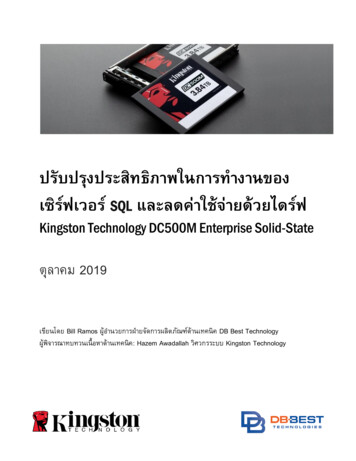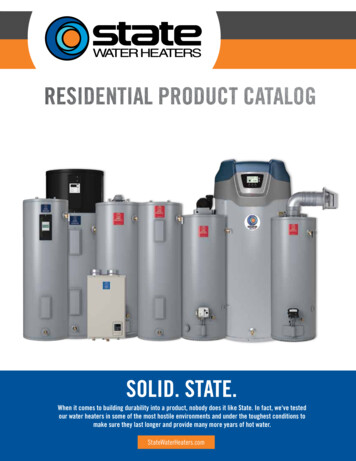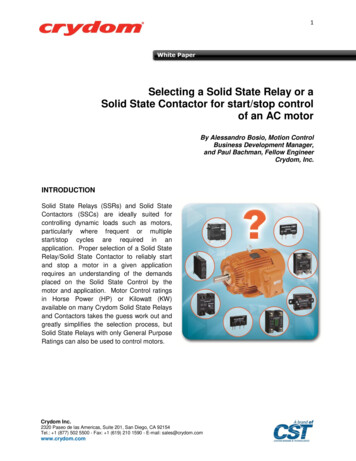
Transcription
1Selecting a Solid State Relay or aSolid State Contactor for start/stop controlof an AC motorBy Alessandro Bosio, Motion ControlBusiness Development Manager,and Paul Bachman, Fellow EngineerCrydom, Inc.INTRODUCTIONSolid State Relays (SSRs) and Solid StateContactors (SSCs) are ideally suited forcontrolling dynamic loads such as motors,particularly where frequent or multiplestart/stop cycles are required in anapplication. Proper selection of a Solid StateRelay/Solid State Contactor to reliably startand stop a motor in a given applicationrequires an understanding of the demandsplaced on the Solid State Control by themotor and application. Motor Control ratingsin Horse Power (HP) or Kilowatt (KW)available on many Crydom Solid State Relaysand Contactors takes the guess work out andgreatly simplifies the selection process, butSolid State Relays with only General PurposeRatings can also be used to control motors.Crydom Inc.2320 Paseo de las Americas, Suite 201, San Diego, CA 92154Tel.: 1 (877) 502 5500 - Fax: 1 (619) 210 1590 - E-mail: sales@crydom.comwww.crydom.com
2This following discusses the process that can be followed to select the correct Solid State Relayfor motor control in those situations where Horse Power (HP) or Kilowatt (KW) ratings of theSolid State Relay may not be known or available.Note: Solid State Relays (SSRs) and Solid State Contactors (SSCs) are essentially if notexactly, the same functionally. The differentiation between them is that by definition a“contactor” must carry a motor control rating in HP or KW, whereas a similar Solid State Relaywith a General Purpose rating may or may not carry a motor control rating as well. Aside fromthe evaluation (testing) process and the resulting approved ratings coordination, there isactually no difference between a Solid State Relay with and without a HP motor rating.FULL LOAD CURRENT (FLA) & LOCKED ROTOR CURRENT (LRA)In those cases where no HP rating for the Solid State Relay is available, aside from correctlymatching the operating and control voltages to the application, the next most importantparameter to consider is the initial inrush current into the motor during the motor’s startingoperation. Motor actuation from a standing position will result in a high initial (or inrush) currentdrawn by the motor to overcome the combined inertial mass of the motor/load system. Largerinertial masses (motor/load) result in higher starting currents and longer duration.Load current reaches its highest value immediately upon actuation as the motor starts from astopped position and is limited only by the value of the motor’s winding resistance. This is atransitory condition that may last from several cycles to seconds depending on the nature of themechanical load and application (spin up). This initial current is essentially equal to the currentdrawn by the motor if its rotor (shaft) was “locked” and could not rotate and therefore isgenerally known as Locked Rotor Current or LRA.As the motor increases it rotational speedup to its operational rating, the currentdecreases to a value that corresponds tothe horse power being delivered to theload. The highest value current drawn inthis state is the motor’s Full LoadCurrent or FLA. See Fig.1.The relationship between Full LoadCurrent (FLA) and Locked Rotor Current(LRA) varies from motor to motor butgenerally falls within a known range.Consequently once we know the steady-Crydom Inc.2320 Paseo de las Americas, Suite 201, San Diego, CA 92154Tel.: 1 (877) 502 5500 - Fax: 1 (619) 210 1590 - E-mail: sales@crydom.comwww.crydom.comFig. 1
3state current (or FLA) of a certain motor we have to consider that the starting inrush current (orLRA) can be 4, 5 8 times the FLA value. Although the LRA may last for only a short period oftime (from a few hundred milliseconds up to 2 seconds or more), the selected SSR needs towithstand these surge values “repetitively” based upon the start/stop frequency required in theapplication.Note: Solid State Relays and Solid State Contactors have no wear out mechanism, and assuch, if properly selected based upon these criteria, will have a significantly longer lifeexpectancy ( 25 years in most cases) than similarly rated mechanical relays or contactors.SELECTING SSRS/SSCS WITH HP/KW RATINGSolid State Relays and Solid State Contactors that have been evaluated by a safety agency orregulatory body as “motor controllers” carry motor power ratings in Horse Power or HP, makingthe controller selection process for any given application much simple because the HP rating iscoordinated by UL or IEC standards with both LRA and FLA ratings. Therefore motor ratedSolid State Relays and Solid State Contactors are often preferred because the necessarycoordination calculations have already been made and validated by the safety agencies.Note: Crydom offers a large number of Motor Control rated products. Theseproducts are summarized in the “Crydom Motion Control Brochure”, created toprovide an overview of the Crydom offer suitable for Motion Control includingthe product’s approved HP/KW ratings and main features. The following is alink to the brochure on the Crydom website:http://www.crydom.com/en/Tech/Brochures/MC brochure.pdfOne important advantage of specifying a motor control rated Solid State Relay or Solid StateContactor is that the agency approval process for the end application is greatly simplified, andfurther, costs associated with approval of the motor control, which can be substantial, are bornby the Solid State Control supplier (Crydom in this case). A number of Crydom’s competitor’sfor one reason or the other have not acquired motor control ratings on their Solid State Relaysand in such cases the end user of such products will bear the cost of approving them for use intheir equipment.Crydom Inc.2320 Paseo de las Americas, Suite 201, San Diego, CA 92154Tel.: 1 (877) 502 5500 - Fax: 1 (619) 210 1590 - E-mail: sales@crydom.comwww.crydom.com
4SELECTING SSRS/SSCS WITHOUT HP/KW RATINGThe following will demonstrate the process to determine the effective ratings of non-motorcontrol rated Solid State Relays for use in motor control applications:Example question: “Can I use a standard Solid State Relay (which is not included in theCrydom Motion Control Brochure and therefore without HP or KW Motor rating) to control thestart/stop of a motor?” The answer: Yes, you need only to consider the motor nominal currentvalue (FLA), inrush current value (LRA), motor power factor (typically 0.1 to 0.9) to select theappropriate turn-on switching type (zero-crossing or random) and possible need for SSRtransient protection to select an appropriate Solid State Relay.To assist in the Solid State Relay selection process, Table 1 below provides a simple andreasonably accurate rule-of-thumb method to coordinate HP/KW rating, FLA current rating,phases and load voltage. The load current values in the Table 1 are typical and based uponindustry average worst case motor ratings with motor efficiency ratings ranging from 20% forsmall type motors to 60% for larger type motors. Note: The values of load current in the tableare FLA run currents of the motor and do not include the start-up surge currents (LRA).However, as discussed earlier in the text, FLA and LRA are coordinated with the HP ratings perthe standards.Full Load Amperes (FLA)Motor PowerHP1/61/41/31/23/411 1/22345 1/27 .51115115V45.26.5811.814192435476180-Single 26Table 1 – Relationship of HP/KW to FLA, phases and load voltageCrydom Inc.2320 Paseo de las Americas, Suite 201, San Diego, CA 92154Tel.: 1 (877) 502 5500 - Fax: 1 (619) 210 1590 - E-mail: 9111721
5For additional assistance in the Solid State Relay selection process, Table 2 provides TypicalSSR motor rating (FLA) versus General Use ratings.The Locked rotor value given in the Table 2 is the true measure of the Solid State Relay surgecapability since this is the parameter that is tested and must comply with UL requirements. (Thegeneral procedure for UL testing is that the SSR must survive a test current of 6 times the fullrating for 1 second. The test is repeated 50 times at a duty cycle of 1 second on, 9 seconds off,with a 0.45 power factor load).SSRGeneral Use RatingAmperesMotor Load AmperesFull Load AmperesFLA (Run)Locked Rotor AmperesLRA 12090201381002515612530180Table 2 – General Use rating current vs FLA/LRANote: Table 2 is representative of all UL approved Crydom SSRs and SSCs. Competitiveproducts may not have similar performance and as a result do not necessarily comply with this“General use vs FLA/LRA value” conversion shown in the table.A final point to be considered when selecting the appropriate Solid State Relay is the turn-onswitching type of the Solid State Relay/Solid State Contactor’s output. For motor control a“Random turn-on” version is generally preferred (excluding certain motor applications withnumerically high power factors 0.85) due to the high inductive nature of the load itself. Zerovoltage/zero crossing/zero turn-on (all refer to the same function) type outputs, which offermajor advantages when controlling resistive loads (with or without significant inrush current),may be a disadvantage in cases with very low numerical power factor loads (typically 0.4).Crydom Inc.2320 Paseo de las Americas, Suite 201, San Diego, CA 92154Tel.: 1 (877) 502 5500 - Fax: 1 (619) 210 1590 - E-mail: sales@crydom.comwww.crydom.com
6The following are 2 examples of how to use the tables when selecting a Solid State Relaywithout an HP/KW rating for a motor control application:Example #1: A Customer would like to use a Crydom Series1 panel mount SSR (which is notMotor control rated) to start/stop a single phase AC motor rated 3 HP @ 230 VAC.From Table 1 we find that the FLA for a single phase 3 HP motor @ 230 VAC is 17 Amp; fromTable 2 we find the SSR General Purpose output rating that corresponds to a 17 Amp FLArating is 75 Amp; consequently, the conclusion is that the customer can use a Crydom D247510 SSR (75 A, 230 VAC, Random turn-on) to control the subject motor.Example #2: A Customer wants to know if he can use the Crydom PF Series PCB mount SSR(which is 25 A General Purpose rated SSR with no Motor Control rating) to start/stop a threephase AC motor rated 2.2 KW @ 400 VAC.From Table 1 we find that the FLA for a three phase 2.2 KW motor @ 400 VAC is 5 Amp; fromTable 2 we find the SSR General Purpose output rating that corresponds to a 5 Amp FLA is 25Amp; consequently, the answer is yes, the customer can use the Crydom PF series SSRbecause it is 25 A General Purpose rated.In conclusion, selection of Solid State Relays or Solid State Contactors that carry Motor ControlRatings is straight forward when the motor load HP or KW ratings are known. However, anyCrydom General Purpose rated Solid State Relay can also be applied using a reasonablysimple process and tables as described in this paper.For further information about Crydom Solid State Relays or Solid State Contactors, contact thenearest Crydom authorized distributor or Crydom Representative, or go to www.crydom.com. Copyright 2013 Crydom Inc., All rights reserved.The materials and information on this document are intended for informational purposes only. Materialsare copyrighted and are protected by worldwide copyright laws and treaty provisions. They may not becopied, reproduced, modified, published, uploaded, posted, transmitted, or distributed in any way, withoutCrydom's prior written permission. Crydom does not warrant the accuracy or completeness of theinformation, text, graphics, links or other items contained within this document. Crydom may makechanges to these materials, or to the products described therein, at any time without notice. Crydommakes no commitment to update the Materials.Crydom Inc.2320 Paseo de las Americas, Suite 201, San Diego, CA 92154Tel.: 1 (877) 502 5500 - Fax: 1 (619) 210 1590 - E-mail: sales@crydom.comwww.crydom.com
Motor Control ratings in Horse Power (HP) or Kilowatt (KW) available on many Crydom Solid State Relays . A final point to be considered when selecting the appropriate Solid State Relay is the turn-on switching type of the Solid State Relay/Solid State
